Transcriptomics Revealed Differentially Expressed Transcription Factors and MicroRNAs in Human Diabetic Foot Ulcers
Abstract
1. Introduction
2. Materials and Methods
3. Results
4. Discussion
5. Conclusions
Supplementary Materials
Funding
Institutional Review Board Statement
Informed Consent Statement
Data Availability Statement
Conflicts of Interest
References
- Boudra, R.; Ramsey, M.R. Understanding Transcriptional Networks Regulating Initiation of Cutaneous Wound Healing. Yale J. Biol. Med. 2020, 93, 161–173. [Google Scholar] [PubMed]
- Shofler, D.; Rai, V.; Mansager, S.; Cramer, K.; Agrawal, D.K. Impact of resolvin mediators in the immunopathology of diabetes and wound healing. Expert Rev. Clin. Immunol. 2021, 17, 681–690. [Google Scholar] [CrossRef] [PubMed]
- Rai, V.; Moellmer, R.; Agrawal, D.K. The role of CXCL8 in chronic nonhealing diabetic foot ulcers and phenotypic changes in fibroblasts: A molecular perspective. Mol. Biol. Rep. 2022, 49, 1565–1572. [Google Scholar] [CrossRef] [PubMed]
- Littig, J.P.B.; Moellmer, R.; Estes, A.M.; Agrawal, D.K.; Rai, V. Increased Population of CD40+ Fibroblasts Is Associated with Impaired Wound Healing and Chronic Inflammation in Diabetic Foot Ulcers. J. Clin. Med. 2022, 11, 6335. [Google Scholar] [CrossRef]
- Rai, V.; Moellmer, R.; Agrawal, D.K. Role of fibroblast plasticity and heterogeneity in modulating angiogenesis and healing in the diabetic foot ulcer. Mol. Biol. Rep. 2023, 50, 1913–1929. [Google Scholar] [CrossRef]
- Rai, V.; Le, H.; Agrawal, D.K. Novel mediators regulating angiogenesis in diabetic foot ulcer healing. Can. J. Physiol. Pharmacol. 2023, 101, 488–501. [Google Scholar] [CrossRef]
- Phillips, T. Regulation of transcription and gene expression in eukaryotes. Nat. Educ. 2008, 1, 199. [Google Scholar]
- Catalanotto, C.; Cogoni, C.; Zardo, G. MicroRNA in Control of Gene Expression: An Overview of Nuclear Functions. Int. J. Mol. Sci. 2016, 17, 1712. [Google Scholar] [CrossRef]
- Hiebert, P.; Werner, S. Regulation of Wound Healing by the NRF2 Transcription Factor-More Than Cytoprotection. Int. J. Mol. Sci. 2019, 20, 3856. [Google Scholar] [CrossRef]
- Gawronska-Kozak, B.; Grabowska, A.; Kur-Piotrowska, A.; Kopcewicz, M. Foxn1 Transcription Factor Regulates Wound Healing of Skin through Promoting Epithelial-Mesenchymal Transition. PLoS ONE 2016, 11, e0150635. [Google Scholar] [CrossRef]
- Ye, P.; Gu, R.; Zhu, H.; Chen, J.; Han, F.; Nie, X. SOX family transcription factors as therapeutic targets in wound healing: A comprehensive review. Int. J. Biol. Macromol. 2023, 253, 127243. [Google Scholar] [CrossRef] [PubMed]
- Miao, C.; Li, Y.; Zhang, X. The functions of FoxO transcription factors in epithelial wound healing. Australas. J. Dermatol. 2019, 60, 105–109. [Google Scholar] [CrossRef] [PubMed]
- Rajendran, N.K.; Dhilip Kumar, S.S.; Houreld, N.N.; Abrahamse, H. Understanding the perspectives of forkhead transcription factors in delayed wound healing. J. Cell Commun. Signal. 2019, 13, 151–162. [Google Scholar] [CrossRef]
- Cioce, A.; Cavani, A.; Cattani, C.; Scopelliti, F. Role of the Skin Immune System in Wound Healing. Cells 2024, 13, 624. [Google Scholar] [CrossRef] [PubMed]
- Raziyeva, K.; Kim, Y.; Zharkinbekov, Z.; Kassymbek, K.; Jimi, S.; Saparov, A. Immunology of Acute and Chronic Wound Healing. Biomolecules 2021, 11, 700. [Google Scholar] [CrossRef] [PubMed]
- Larouche, J.; Sheoran, S.; Maruyama, K.; Martino, M.M. Immune Regulation of Skin Wound Healing: Mechanisms and Novel Therapeutic Targets. Adv. Wound Care 2018, 7, 209–231. [Google Scholar] [CrossRef]
- Zandigohar, M.; Pang, J.; Rodrigues, A.; Roberts, R.E.; Dai, Y.; Koh, T.J. Transcription Factor Activity Regulating Macrophage Heterogeneity during Skin Wound Healing. J. Immunol. 2024, 213, 506–518. [Google Scholar] [CrossRef]
- Parella, K.; Moody, K.; Wortel, D.; Colegrove, H.; Elser, J.A. HOXA3 accelerates wound healing in diabetic and aged non-diabetic mammals. Sci. Rep. 2023, 13, 9923. [Google Scholar] [CrossRef]
- Yang, Y.; Zhang, B.; Yang, Y.; Peng, B.; Ye, R. FOXM1 accelerates wound healing in diabetic foot ulcer by inducing M2 macrophage polarization through a mechanism involving SEMA3C/NRP2/Hedgehog signaling. Diabetes Res. Clin. Pract. 2022, 184, 109121. [Google Scholar] [CrossRef]
- Kim, E.; Seo, S.H.; Hwang, Y.; Ryu, Y.C.; Kim, H.; Lee, K.M.; Lee, J.W.; Park, K.H.; Choi, K.Y. Inhibiting the cytosolic function of CXXC5 accelerates diabetic wound healing by enhancing angiogenesis and skin repair. Exp. Mol. Med. 2023, 55, 1770–1782. [Google Scholar] [CrossRef]
- Zhang, A.; Matsuoka, K.; Kareem, A.; Robert, M.; Roszak, P.; Blob, B.; Bisht, A.; De Veylder, L.; Voiniciuc, C.; Asahina, M.; et al. Cell-wall damage activates DOF transcription factors to promote wound healing and tissue regeneration in Arabidopsis thaliana. Curr. Biol. 2022, 32, 1883–1894.e1887. [Google Scholar] [CrossRef] [PubMed]
- Rai, V.; Agrawal, D.K. Role of Transcription Factors and MicroRNAs in Regulating Fibroblast Reprogramming in Wound Healing. J. Bioinform. Syst. Biol. 2023, 6, 110–120. [Google Scholar] [CrossRef] [PubMed]
- Gu, J.; Iyer, V.R. PI3K signaling and miRNA expression during the response of quiescent human fibroblasts to distinct proliferative stimuli. Genome Biol. 2006, 7, R42. [Google Scholar] [CrossRef] [PubMed]
- Xie, J.; Wu, W.; Zheng, L.; Lin, X.; Tai, Y.; Wang, Y.; Wang, L. Roles of MicroRNA-21 in Skin Wound Healing: A Comprehensive Review. Front. Pharmacol. 2022, 13, 828627. [Google Scholar] [CrossRef]
- Hu, K.; Liu, L.; Tang, S.; Zhang, X.; Chang, H.; Chen, W.; Fan, T.; Zhang, L.; Shen, B.; Zhang, Q. MicroRNA-221-3p inhibits the inflammatory response of keratinocytes by regulating the DYRK1A/STAT3 signaling pathway to promote wound healing in diabetes. Commun. Biol. 2024, 7, 300. [Google Scholar] [CrossRef]
- Banerjee, J.; Sen, C.K. microRNA and Wound Healing. Adv. Exp. Med. Biol. 2015, 888, 291–305. [Google Scholar] [CrossRef]
- Jiang, Y.; Xu, X.; Xiao, L.; Wang, L.; Qiang, S. The Role of microRNA in the Inflammatory Response of Wound Healing. Front. Immunol. 2022, 13, 852419. [Google Scholar] [CrossRef] [PubMed]
- Azevedo, M.L.; Silveira, R.G.; Nedel, F.; Lund, R.G. Correction: MicroRNAs expressed during normal wound healing and their associated pathways: A systematic review and bioinformatics analysis. PLoS ONE 2023, 18, e0294488. [Google Scholar] [CrossRef]
- Rai, V.; Mendoza-Mari, Y.; Brazdzionis, J.; Radwan, M.M.; Connett, D.A.; Miulli, D.E.; Agrawal, D.K. Transcriptomic Analysis of Gene Expression and Effect of Electromagnetic Field in Brain Tissue after Traumatic Brain Injury. J. Biotechnol. Biomed. 2024, 7, 101–110. [Google Scholar] [CrossRef]
- Krämer, A.; Green, J.; Pollard, J., Jr.; Tugendreich, S. Causal analysis approaches in ingenuity pathway analysis. Bioinformatics 2014, 30, 523–530. [Google Scholar] [CrossRef]
- Amin, K.N.; Umapathy, D.; Anandharaj, A.; Ravichandran, J.; Sasikumar, C.S.; Chandra, S.K.R.; Kesavan, R.; Kunka Mohanram, R. miR-23c regulates wound healing by targeting stromal cell-derived factor-1alpha (SDF-1alpha/CXCL12) among patients with diabetic foot ulcer. Microvasc. Res. 2020, 127, 103924. [Google Scholar] [CrossRef] [PubMed]
- Cai, H.A.; Huang, L.; Zheng, L.J.; Fu, K.; Wang, J.; Hu, F.D.; Liao, R.Y. Ginsenoside (Rg-1) promoted the wound closure of diabetic foot ulcer through iNOS elevation via miR-23a/IRF-1 axis. Life Sci. 2019, 233, 116525. [Google Scholar] [CrossRef] [PubMed]
- Zhang, Y.; Zhang, J.; Xu, Z.; Zhang, D.; Xia, P.; Ling, J.; Tang, X.; Liu, X.; Xuan, R.; Zhang, M.; et al. Regulation of NcRNA-protein binding in diabetic foot. Biomed. Pharmacother. 2023, 160, 114361. [Google Scholar] [CrossRef]
- Hu, H.; Tang, J.; Liu, C.; Cen, Y. MiR-23b Promotes the Migration of Keratinocytes Through Downregulating TIMP3. J. Surg. Res. 2020, 254, 102–109. [Google Scholar] [CrossRef] [PubMed]
- Lyttle, B.D.; Vaughn, A.E.; Bardill, J.R.; Apte, A.; Gallagher, L.T.; Zgheib, C.; Liechty, K.W. Effects of microRNAs on angiogenesis in diabetic wounds. Front. Med. 2023, 10, 1140979. [Google Scholar] [CrossRef]
- Tiwari, A.; Mukherjee, B.; Dixit, M. MicroRNA Key to Angiogenesis Regulation: MiRNA Biology and Therapy. Curr. Cancer Drug Targets 2018, 18, 266–277. [Google Scholar] [CrossRef]
- Pichu, S.; Vimalraj, S.; Viswanathan, V. Impact of microRNA-210 on wound healing among the patients with diabetic foot ulcer. PLoS ONE 2021, 16, e0254921. [Google Scholar] [CrossRef]
- de Oliveira Andrade, L.J.; Vinhaes Bittencourt, A.M.; Matos de Oliveira, L.; Matos de Oliveira, G.C. microRNAs Over-expressed in Diabetic Foot Ulcers Healing-Computational Modeling of Molecular Structure. arXiv 2021, arXiv:2021-07. [Google Scholar]
- Biswas, S.; Roy, S.; Banerjee, J.; Hussain, S.R.; Khanna, S.; Meenakshisundaram, G.; Kuppusamy, P.; Friedman, A.; Sen, C.K. Hypoxia inducible microRNA 210 attenuates keratinocyte proliferation and impairs closure in a murine model of ischemic wounds. Proc. Natl. Acad. Sci. USA 2010, 107, 6976–6981. [Google Scholar] [CrossRef]
- Narayanan, S.; Eliasson Angelstig, S.; Xu, C.; Grunler, J.; Zhao, A.; Zhu, W.; Xu Landen, N.; Stahle, M.; Zhang, J.; Ivan, M.; et al. HypoxamiR-210 accelerates wound healing in diabetic mice by improving cellular metabolism. Commun. Biol. 2020, 3, 768. [Google Scholar] [CrossRef] [PubMed]
- Bakr Zaki, M.; Abulsoud, A.I.; Elsisi, A.M.; Doghish, A.S.; Mansour, O.A.E.; Amin, A.I.; Elrebehy, M.A.; Mohamed, M.Y.; Goda, M.A. Potential role of circulating microRNAs (486-5p, 497, 509–5p and 605) in metabolic syndrome Egyptian male patients. Diabetes Metab. Syndr. Obes. 2019, 12, 601–611. [Google Scholar] [CrossRef] [PubMed]
- Lu, Y.; Wen, H.; Huang, J.; Liao, P.; Liao, H.; Tu, J.; Zeng, Y. Extracellular vesicle-enclosed miR-486-5p mediates wound healing with adipose-derived stem cells by promoting angiogenesis. J. Cell. Mol. Med. 2020, 24, 9590–9604. [Google Scholar] [CrossRef] [PubMed]
- Deng, H.; Chen, Y. The role of adipose-derived stem cells-derived extracellular vesicles in the treatment of diabetic foot ulcer: Trends and prospects. Front. Endocrinol. 2022, 13, 902130. [Google Scholar] [CrossRef] [PubMed]
- Gu, C.; Zhang, M.; Sun, W.; Dong, C. Upregulation of miR-324-5p Inhibits Proliferation and Invasion of Colorectal Cancer Cells by Targeting ELAVL1. Oncol. Res. 2019, 27, 515–524. [Google Scholar] [CrossRef]
- Wang, Y.; Li, Y.; Ni, D.; Wei, Z.; Fu, Z.; Li, C.; Sun, H.; Wu, Y.; Li, Y.; Zhang, Y.; et al. miR-186-5p targets TGFbetaR2 to inhibit RAW264.7 cell migration and proliferation during mouse skin wound healing. Environ. Toxicol. 2023, 38, 2826–2835. [Google Scholar] [CrossRef]
- Wang, H.; Wang, X.; Liu, X.; Zhou, J.; Yang, Q.; Chai, B.; Chai, Y.; Ma, Z.; Lu, S. miR-199a-5p Plays a Pivotal Role on Wound Healing via Suppressing VEGFA and ROCK1 in Diabetic Ulcer Foot. Oxid Med. Cell. Longev. 2022, 2022, 4791059. [Google Scholar] [CrossRef]
- Siu, M.C.; Voisey, J.; Zang, T.; Cuttle, L. MicroRNAs involved in human skin burns, wound healing and scarring. Wound Repair Regen. 2023, 31, 439–453. [Google Scholar] [CrossRef]
- Yan, S.; Chen, J.; Zhang, T.; Zhou, J.; Wang, G.; Li, Y. Micro-RNA-338-3p Promotes the Development of Atherosclerosis by Targeting Desmin and Promoting Proliferation. Mol. Biotechnol. 2021, 63, 840–848. [Google Scholar] [CrossRef]
- Liu, J.; Cao, L.; Feng, Y.; Li, Y.; Li, T. MiR-338-3p inhibits TNF-alpha-induced lipogenesis in human sebocytes. Biotechnol. Lett. 2017, 39, 1343–1349. [Google Scholar] [CrossRef]
- Mulholland, E.J.; Dunne, N.; McCarthy, H.O. MicroRNA as Therapeutic Targets for Chronic Wound Healing. Mol. Ther. Nucleic. Acids 2017, 8, 46–55. [Google Scholar] [CrossRef]
- Moura, J.; Sorensen, A.; Leal, E.C.; Svendsen, R.; Carvalho, L.; Willemoes, R.J.; Jorgensen, P.T.; Jenssen, H.; Wengel, J.; Dalgaard, L.T.; et al. microRNA-155 inhibition restores Fibroblast Growth Factor 7 expression in diabetic skin and decreases wound inflammation. Sci. Rep. 2019, 9, 5836. [Google Scholar] [CrossRef] [PubMed]
- Wang, C.R.; Zhu, H.F.; Zhu, Y. Knockout of MicroRNA-155 Ameliorates the Th17/Th9 Immune Response and Promotes Wound Healing. Curr. Med. Sci. 2019, 39, 954–964. [Google Scholar] [CrossRef] [PubMed]
- Liu, L.; Zhang, W.; Hu, Y.; Ma, L.; Xu, X. Downregulation of miR-1225-5p is pivotal for proliferation, invasion, and migration of HCC cells through NFkappaB regulation. J. Clin. Lab. Anal. 2020, 34, e23474. [Google Scholar] [CrossRef] [PubMed]
- Mori, R.; Tanaka, K.; Shimokawa, I. Identification and functional analysis of inflammation-related miRNAs in skin wound repair. Dev. Growth Differ. 2018, 60, 306–315. [Google Scholar] [CrossRef]
- Li, B.; Xu, W.W.; Han, L.; Chan, K.T.; Tsao, S.W.; Lee, N.P.Y.; Law, S.; Xu, L.Y.; Li, E.M.; Chan, K.W.; et al. MicroRNA-377 suppresses initiation and progression of esophageal cancer by inhibiting CD133 and VEGF. Oncogene 2017, 36, 3986–4000. [Google Scholar] [CrossRef]
- Shi, M.; Zong, X.; Chen, L.; Guo, X.; Ding, X. MiR-506-3p regulates autophagy and proliferation in post-burn skin fibroblasts through post-transcriptionally suppressing Beclin-1 expression. Vitr. Cell Dev. Biol. Anim. 2020, 56, 522–532. [Google Scholar] [CrossRef]
- Li, F.; Wan, D.W.; Hu, J.; Qin, R. Effect of artificial skin membrane on the expression of miR-155 and miR-506-3p in patients with second-degree burns. J. Clin. Lab. Anal. 2022, 36, e24564. [Google Scholar] [CrossRef]
- He, L.; Zhu, C.; Jia, J.; Hao, X.Y.; Yu, X.Y.; Liu, X.Y.; Shu, M.G. ADSC-Exos containing MALAT1 promotes wound healing by targeting miR-124 through activating Wnt/beta-catenin pathway. Biosci. Rep. 2020, 40, BSR20192549. [Google Scholar] [CrossRef]
- Chen, X.; Yang, R.; Wang, J.; Ruan, S.; Lin, Z.; Xin, Q.; Yang, R.; Xie, J. Porcine acellular dermal matrix accelerates wound healing through miR-124-3p.1 and miR-139-5p. Cytotherapy 2020, 22, 494–502. [Google Scholar] [CrossRef]
- Liu, Z.; Zhang, L.; Toma, M.A.; Li, D.; Bian, X.; Pastar, I.; Tomic-Canic, M.; Sommar, P.; Xu Landen, N. Integrative small and long RNA omics analysis of human healing and nonhealing wounds discovers cooperating microRNAs as therapeutic targets. Elife 2022, 11, e80322. [Google Scholar] [CrossRef]
- Arodz, T.; Bonchev, D.; Diegelmann, R.F. A Network Approach to Wound Healing. Adv. Wound Care 2013, 2, 499–509. [Google Scholar] [CrossRef] [PubMed]
- Braddock, M. The transcription factor Egr-1: A potential drug in wound healing and tissue repair. Ann. Med. 2001, 33, 313–318. [Google Scholar] [CrossRef] [PubMed]
- Schafer, M.; Werner, S. Transcriptional control of wound repair. Annu. Rev. Cell Dev. Biol. 2007, 23, 69–92. [Google Scholar] [CrossRef] [PubMed]
- Gross, C.; Le-Bel, G.; Desjardins, P.; Benhassine, M.; Germain, L.; Guerin, S.L. Contribution of the Transcription Factors Sp1/Sp3 and AP-1 to Clusterin Gene Expression during Corneal Wound Healing of Tissue-Engineered Human Corneas. Int. J. Mol. Sci. 2021, 22, 12426. [Google Scholar] [CrossRef]
- Xia, C.; Braunstein, Z.; Toomey, A.C.; Zhong, J.; Rao, X. S100 Proteins As an Important Regulator of Macrophage Inflammation. Front. Immunol. 2017, 8, 1908. [Google Scholar] [CrossRef]
- Singh, K.; Agrawal, N.K.; Gupta, S.K.; Sinha, P.; Singh, K. Increased expression of TLR9 associated with pro-inflammatory S100A8 and IL-8 in diabetic wounds could lead to unresolved inflammation in type 2 diabetes mellitus (T2DM) cases with impaired wound healing. J. Diabetes Complicat. 2016, 30, 99–108. [Google Scholar] [CrossRef]
- Su, W.; Wang, P.; Dong, Q.; Li, S.; Hu, S. S100A8 accelerates wound healing by promoting adipose stem cell proliferation and suppressing inflammation. Regen. Ther. 2022, 21, 166–174. [Google Scholar] [CrossRef] [PubMed]
- Sun, X.; Chuang, J.C.; Kanchwala, M.; Wu, L.; Celen, C.; Li, L.; Liang, H.; Zhang, S.; Maples, T.; Nguyen, L.H.; et al. Suppression of the SWI/SNF Component Arid1a Promotes Mammalian Regeneration. Cell Stem Cell 2016, 18, 456–466. [Google Scholar] [CrossRef]
- Zhang, Y.; Qian, H.S.; Hu, G.; Wang, L.; Zhu, Y. ARID1A is involved in DNA double-strand break repair in gastric cancer. J. Gastrointest. Oncol. 2024, 15, 862–872. [Google Scholar] [CrossRef]
- Xu, L.; Humphries, F.; Delagic, N.; Wang, B.; Holland, A.; Edgar, K.S.; Hombrebueno, J.R.; Stolz, D.B.; Oleszycka, E.; Rodgers, A.M.; et al. ECSIT is a critical limiting factor for cardiac function. JCI Insight 2021, 6, e142801. [Google Scholar] [CrossRef]
- Noguchi, F.; Nakajima, T.; Inui, S.; Reddy, J.K.; Itami, S. Alteration of skin wound healing in keratinocyte-specific mediator complex subunit 1 null mice. PLoS ONE 2014, 9, e102271. [Google Scholar] [CrossRef] [PubMed]
- Meng, Z.; Li, Z.; Guo, S.; Wu, D.; Wei, R.; Liu, J.; Hu, L.; Sui, L. MED1 Ablation Promotes Oral Mucosal Wound Healing via JNK Signaling Pathway. Int. J. Mol. Sci. 2022, 23, 13414. [Google Scholar] [CrossRef] [PubMed]
- Ambrozova, N.; Ulrichova, J.; Galandakova, A. Models for the study of skin wound healing. The role of Nrf2 and NF-kappaB. Biomed. Pap. Med. Fac. Palacky Univ. Olomouc 2017, 161, 1–13. [Google Scholar] [CrossRef] [PubMed]
- Park, Y.R.; Sultan, M.T.; Park, H.J.; Lee, J.M.; Ju, H.W.; Lee, O.J.; Lee, D.J.; Kaplan, D.L.; Park, C.H. NF-kappaB signaling is key in the wound healing processes of silk fibroin. Acta Biomater. 2018, 67, 183–195. [Google Scholar] [CrossRef] [PubMed]
- Catar, R.; Witowski, J.; Zhu, N.; Lucht, C.; Derrac Soria, A.; Uceda Fernandez, J.; Chen, L.; Jones, S.A.; Fielding, C.A.; Rudolf, A.; et al. IL-6 Trans-Signaling Links Inflammation with Angiogenesis in the Peritoneal Membrane. J. Am. Soc. Nephrol. 2017, 28, 1188–1199. [Google Scholar] [CrossRef]
- Nguyen, P.D.; Tutela, J.P.; Thanik, V.D.; Knobel, D.; Allen, R.J., Jr.; Chang, C.C.; Levine, J.P.; Warren, S.M.; Saadeh, P.B. Improved diabetic wound healing through topical silencing of p53 is associated with augmented vasculogenic mediators. Wound Repair Regen. 2010, 18, 553–559. [Google Scholar] [CrossRef] [PubMed]
- Theocharidis, G.; Baltzis, D.; Roustit, M.; Tellechea, A.; Dangwal, S.; Khetani, R.S.; Shu, B.; Zhao, W.; Fu, J.; Bhasin, S.; et al. Integrated Skin Transcriptomics and Serum Multiplex Assays Reveal Novel Mechanisms of Wound Healing in Diabetic Foot Ulcers. Diabetes 2020, 69, 2157–2169. [Google Scholar] [CrossRef]
- Zhang, Y.; Li, T.; Wang, F.; Liao, C.; Song, S.; Sun, M.; Zhang, W. STAT3 Contributes to Wound Healing in Diabetic Foot Ulcer by Targeting the CHI3L1/MAPK Axis. J. Biol. Regul. Homeost. Agents 2024, 38, 2661–2672. [Google Scholar]
- Piipponen, M.; Li, D.; Landen, N.X. The Immune Functions of Keratinocytes in Skin Wound Healing. Int. J. Mol. Sci. 2020, 21, 8790. [Google Scholar] [CrossRef] [PubMed]
- Mariadoss, A.V.A.; Sivakumar, A.S.; Lee, C.H.; Kim, S.J. Diabetes mellitus and diabetic foot ulcer: Etiology, biochemical and molecular based treatment strategies via gene and nanotherapy. Biomed. Pharmaco. 2022, 151, 113134. [Google Scholar] [CrossRef] [PubMed]
- Chen, J.; Qin, S.; Liu, S.; Zhong, K.; Jing, Y.; Wu, X.; Peng, F.; Li, D.; Peng, C. Targeting matrix metalloproteases in diabetic wound healing. Front. Immunol. 2023, 14, 1089001. [Google Scholar] [CrossRef]
- Xiang, Z.; Cai, R.P.; Xiao, Y.; Huang, Y.C. Single-cell sequencing technology in diabetic wound healing: New insights into the progenitors-based repair strategies. World J. Stem Cells 2024, 16, 462–466. [Google Scholar] [CrossRef] [PubMed]
- Iglesias-Bartolome, R.; Uchiyama, A.; Molinolo, A.A.; Abusleme, L.; Brooks, S.R.; Callejas-Valera, J.L.; Edwards, D.; Doci, C.; Asselin-Labat, M.L.; Onaitis, M.W.; et al. Transcriptional signature primes human oral mucosa for rapid wound healing. Sci. Transl. Med. 2018, 10, eaap8798. [Google Scholar] [CrossRef] [PubMed]
- Wang, J.M.; Li, H.; Xu, L.; Kim, H.; Qiu, Y.; Zhang, K. Boosting UPR transcriptional activator XBP1 accelerates acute wound healing. PNAS Nexus 2023, 2, pgad050. [Google Scholar] [CrossRef]
- Huang, M.; Huang, X.; Jiang, B.; Zhang, P.; Guo, L.; Cui, X.; Zhou, S.; Ren, L.; Zhang, M.; Zeng, J.; et al. linc00174-EZH2-ZNF24/Runx1-VEGFA Regulatory Mechanism Modulates Post-burn Wound Healing. Mol. Ther. Nucleic Acids 2020, 21, 824–836. [Google Scholar] [CrossRef]
- Wang, Y.; Pi, Y.; Hu, L.; Peng, Z.; Hu, H.; Zhao, J.; Zhou, Y.; Wang, D. Proteomic analysis of foot ulcer tissue reveals novel potential therapeutic targets of wound healing in diabetic foot ulcers. Comput. Biol. Med. 2023, 159, 106858. [Google Scholar] [CrossRef]
- Jia, Z.; Liu, L.; Zhang, S.; Zhao, X.; Luo, L.; Tang, Y.; Shen, B.; Chen, M. Proteomics changes after negative pressure wound therapy in diabetic foot ulcers. Mol. Med. Rep. 2021, 24, 834. [Google Scholar] [CrossRef]
- Yu, X.T.; Wang, F.; Ding, J.T.; Cai, B.; Xing, J.J.; Guo, G.H.; Guo, F. Tandem mass tag-based serum proteomic profiling revealed diabetic foot ulcer pathogenesis and potential therapeutic targets. Bioengineered 2022, 13, 3171–3182. [Google Scholar] [CrossRef]
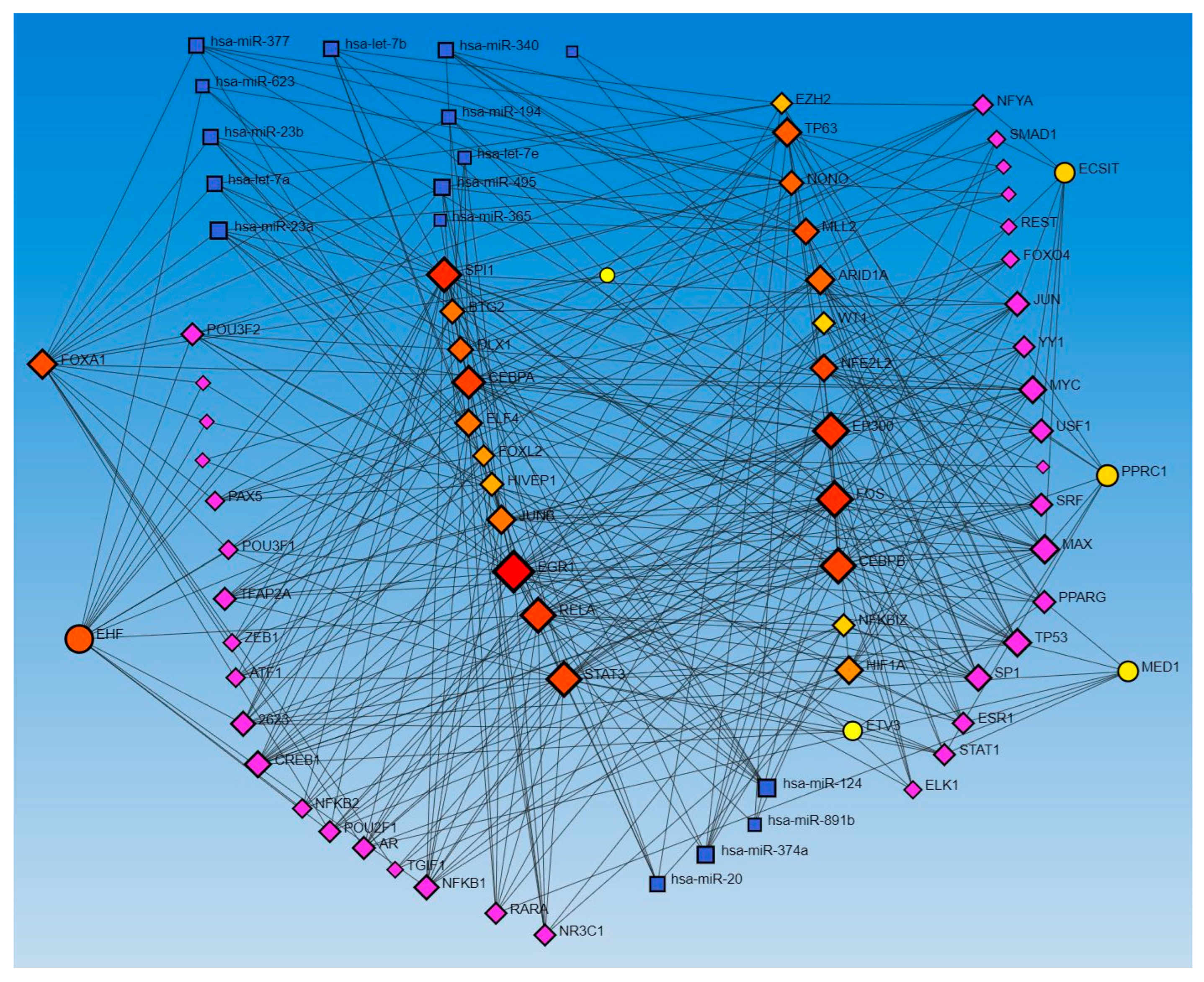
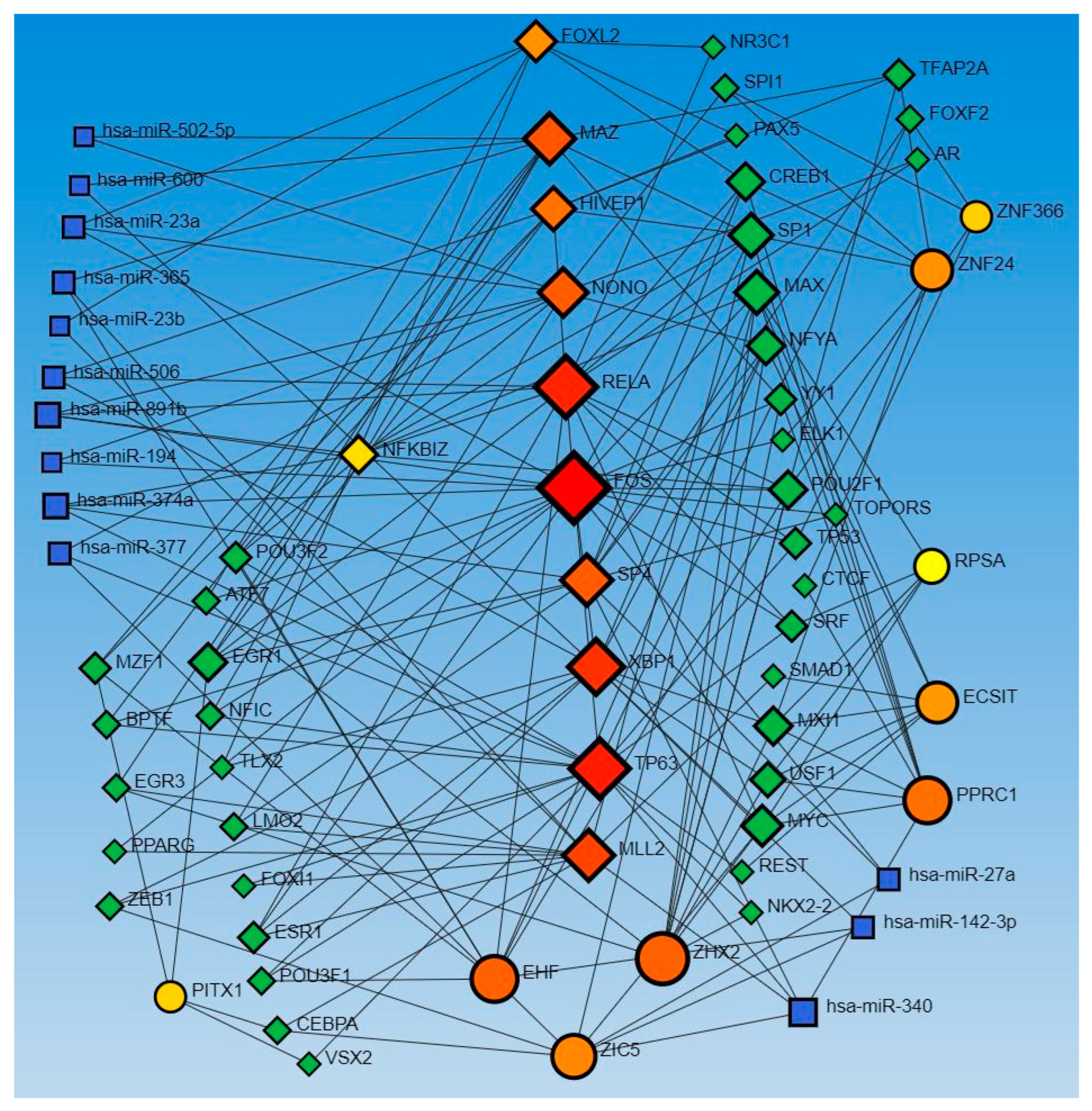
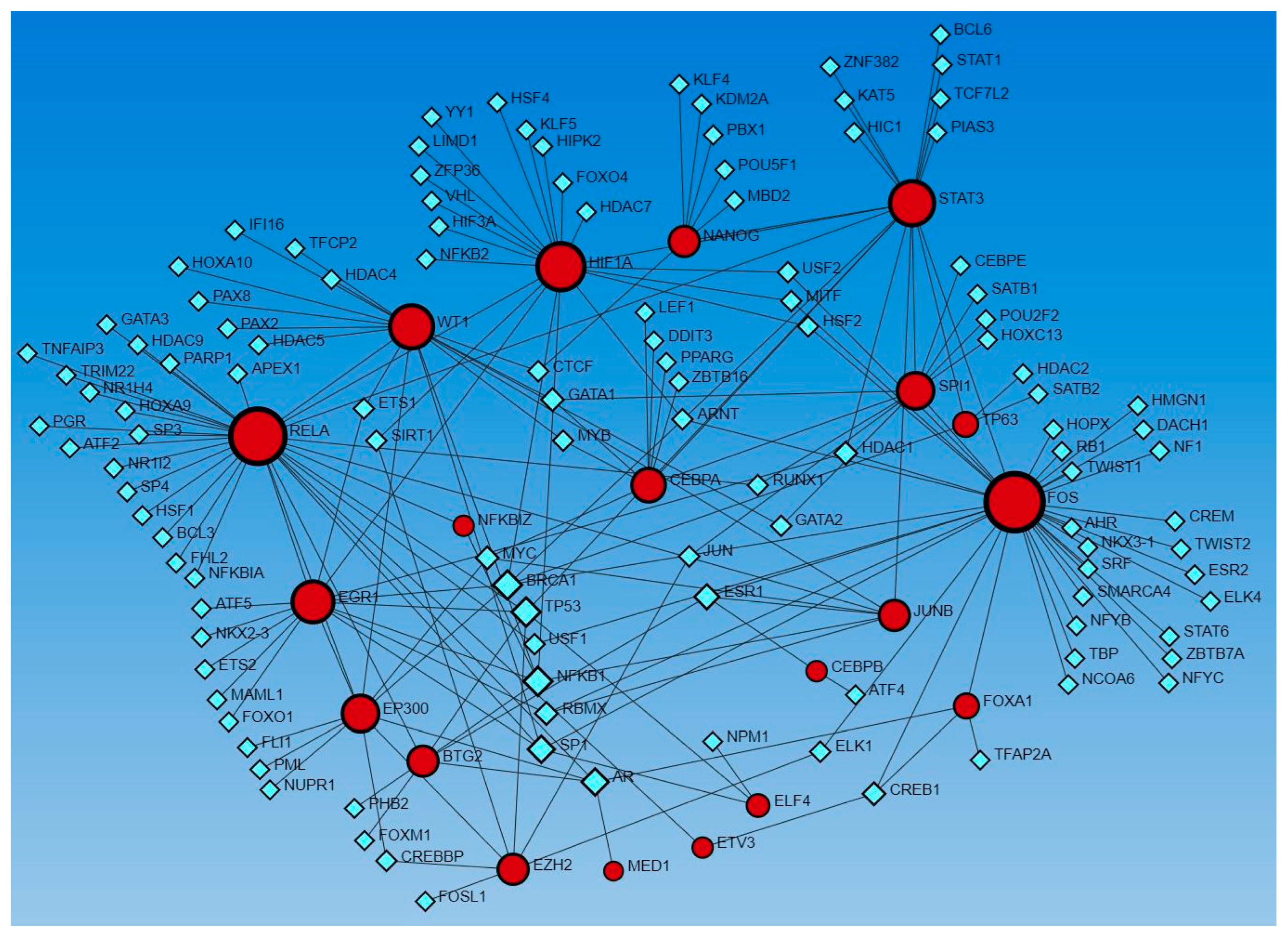
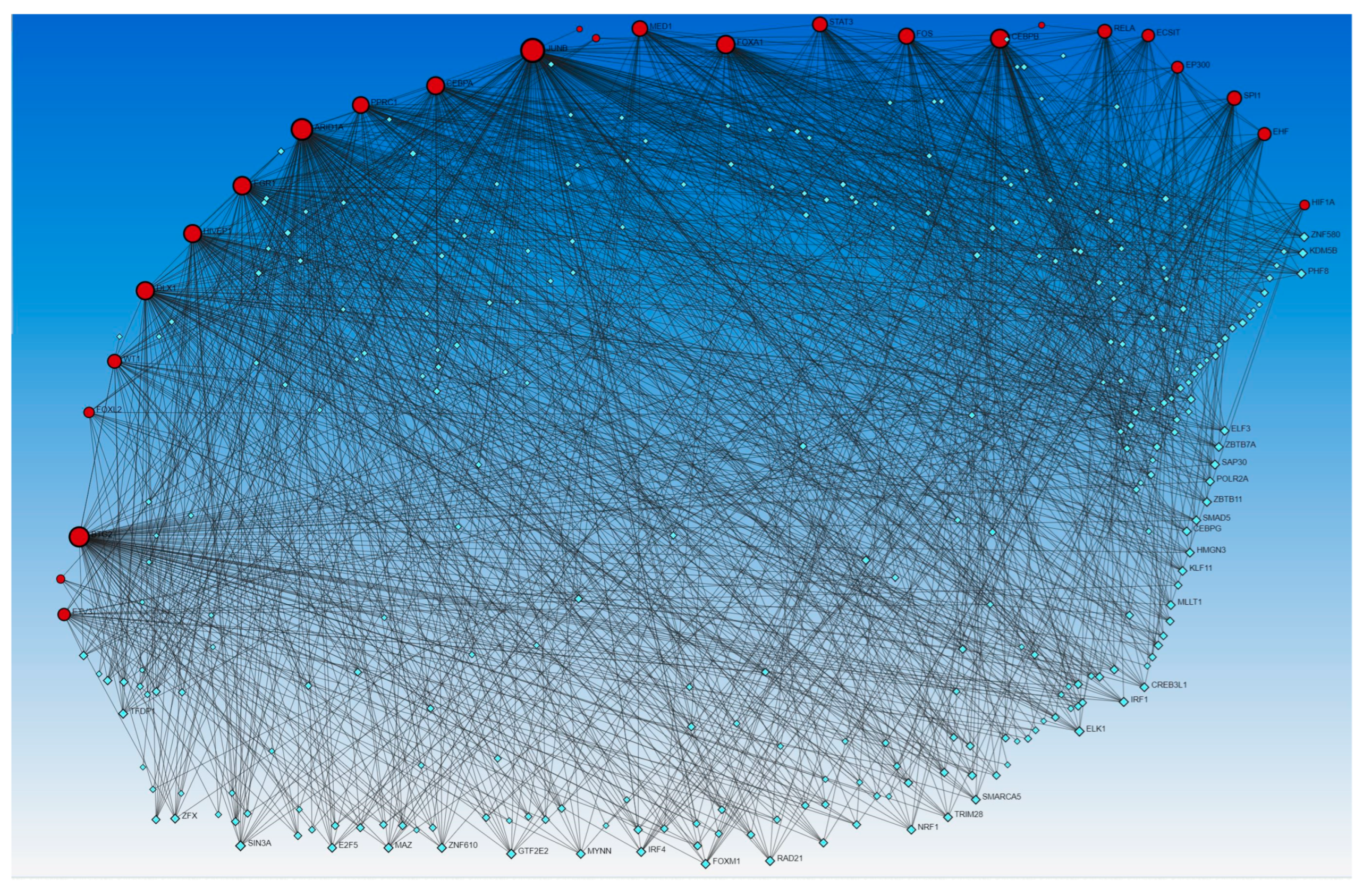
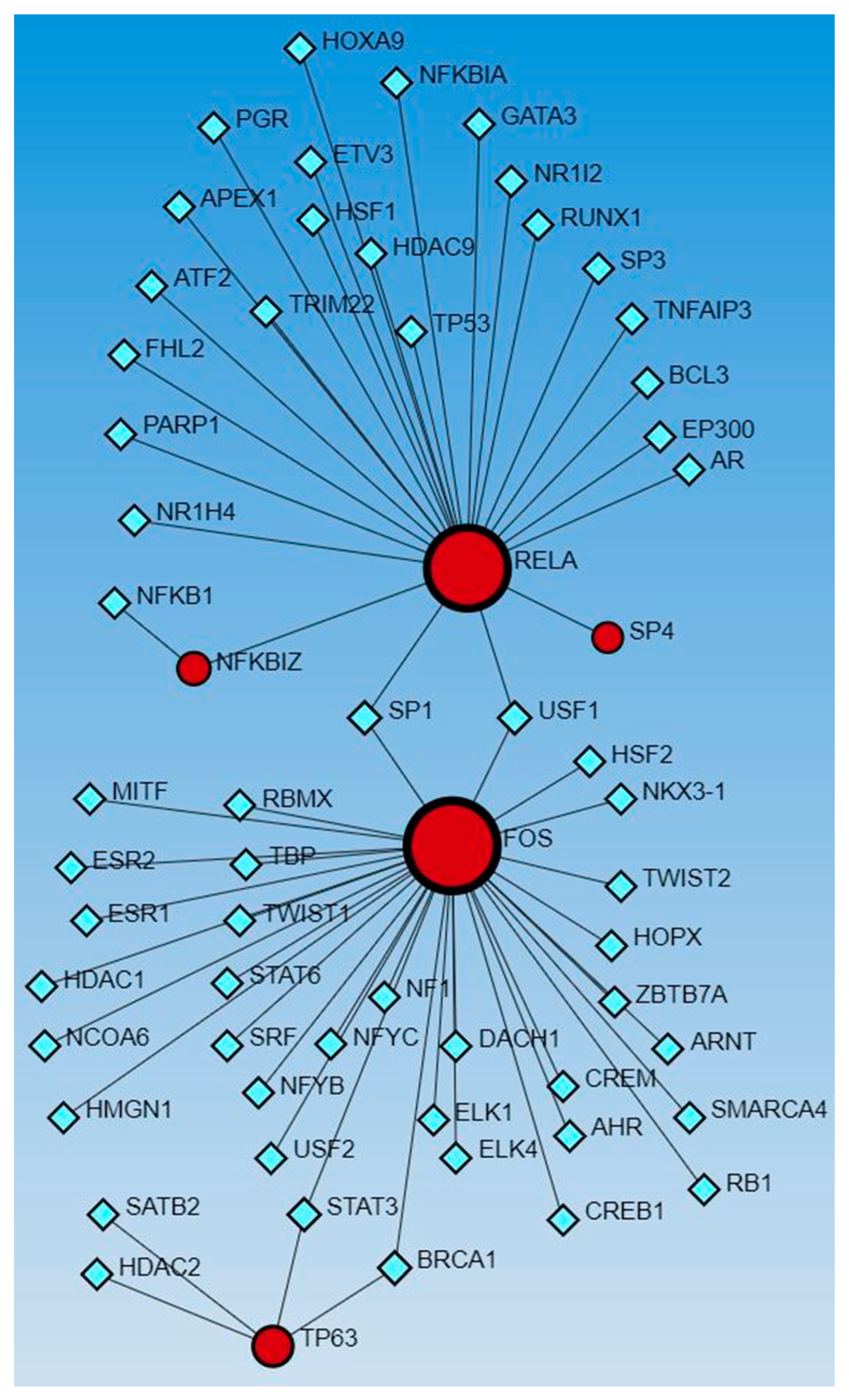
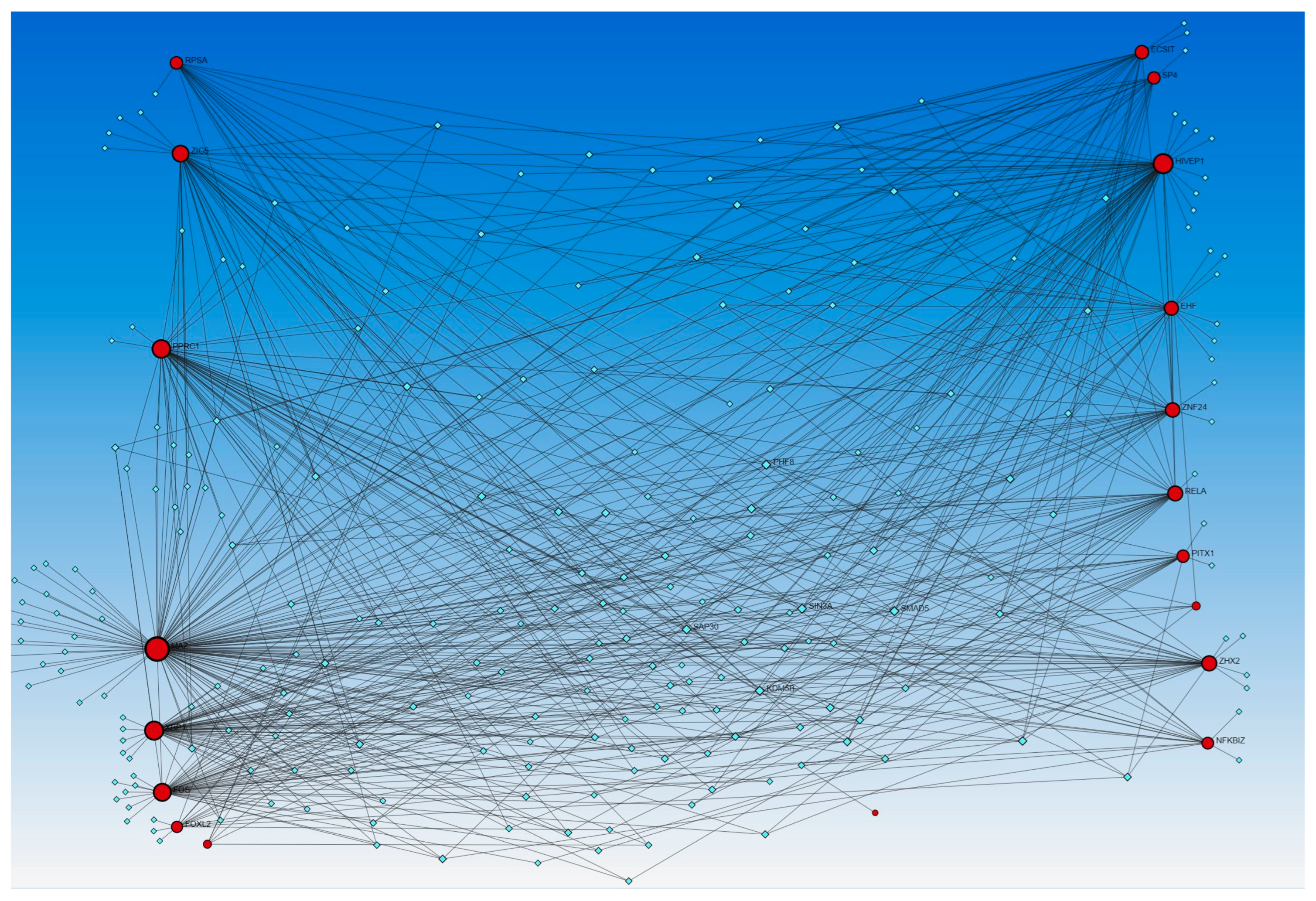
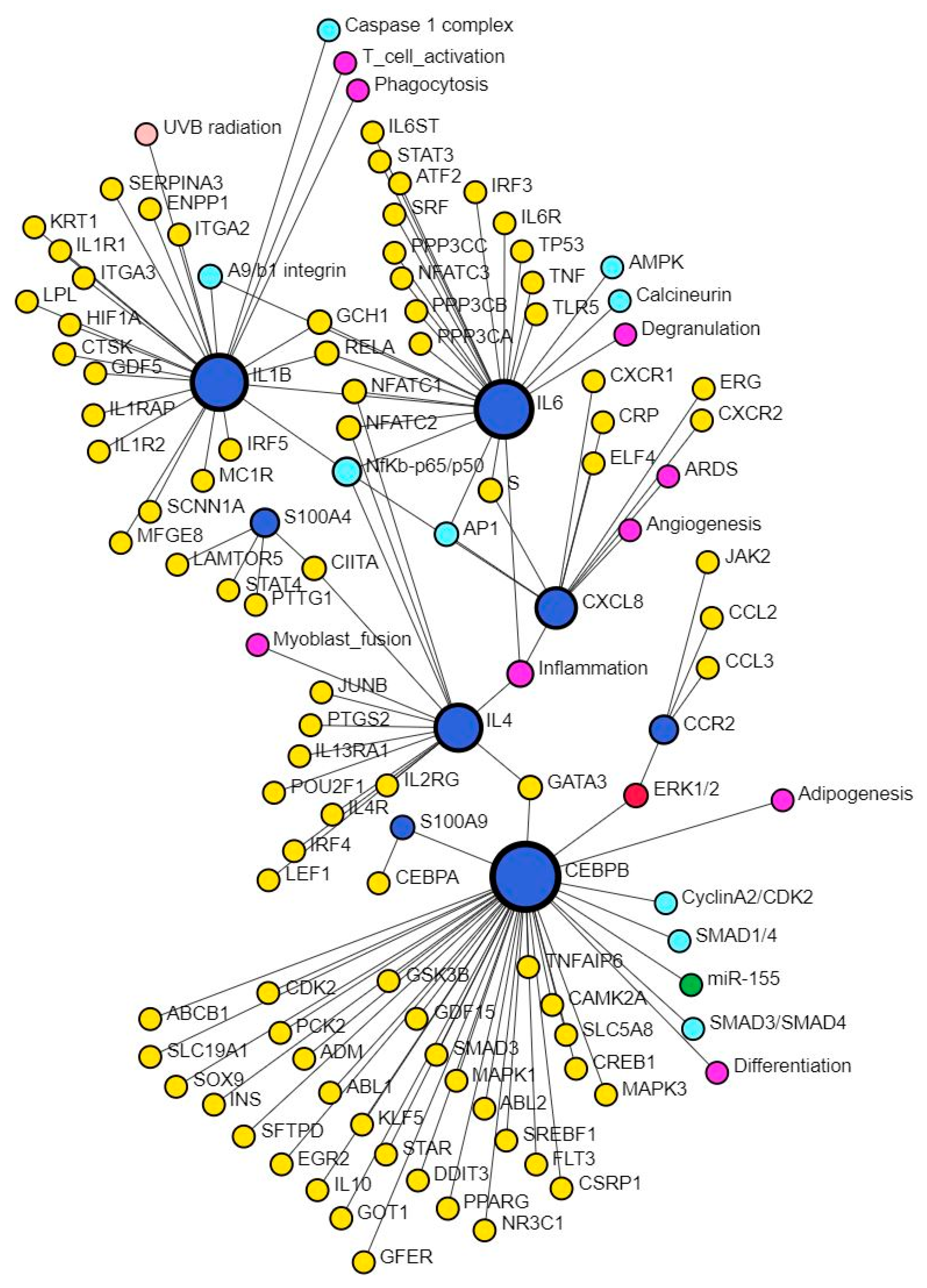
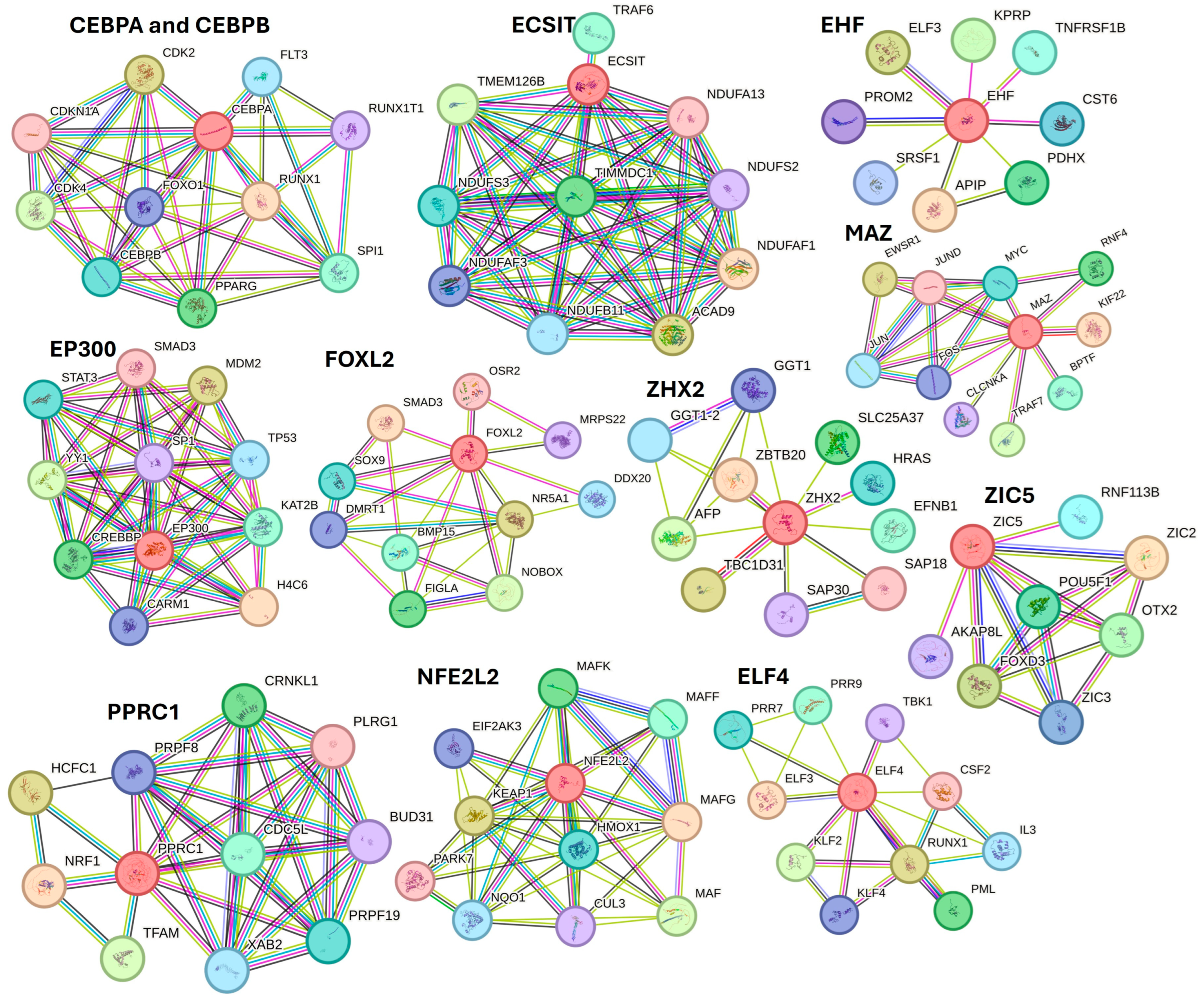
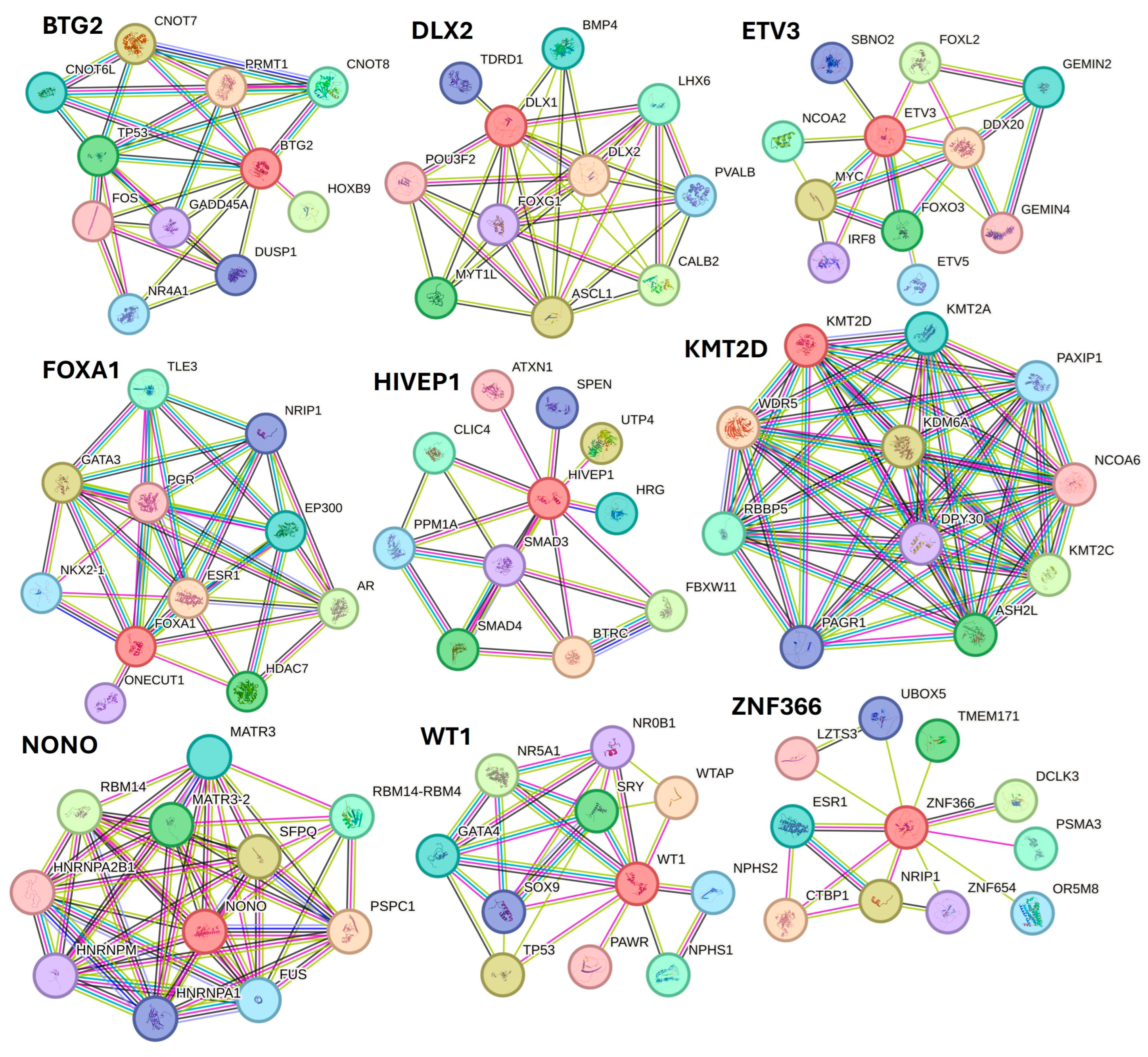
| Upstream Regulator Analysis | Causal Network Analysis | ||||
|---|---|---|---|---|---|
| Transcriptional Regulators | Activation Status | Activation z-Score | Transcriptional Regulators | Activation Status | Activation z-Score |
| EHF | Activated | 2.714 | MAZ | Activated | 6.042 |
| NONO | Activated | 3.984 | NONO | Activated | 3.77 |
| TP63 | Activated | 4.615 | ZIC5 | Activated | 4.346 |
| NFKBIZ | Activated | 2.755 | TP63 | Activated | 4.743 |
| RELA | Activated | 3.49 | EHF | Activated | 3.683 |
| PPRC1 | Activated | 3.064 | EHF | Activated | 2.683 |
| FOXL2 | Activated | 2.811 | RELA | Activated | 4.111 |
| FOS | Activated | 2.732 | NONO | Activated | 4.082 |
| ECSIT | Activated | 2.63 | ECSIT | Activated | 4.004 |
| JUNB | Activated | 2.236 | NFKBIZ | Activated | 2.828 |
| CEBPA | Activated | 3.208 | PPRC1 | Activated | 3.051 |
| HIF1A | Activated | 2.431 | RELA | Activated | 3.545 |
| EZH2 | Activated | 2.668 | FOXL2 | Activated | 2.887 |
| CEBPB | Activated | 2.148 | FOS | Activated | 2.985 |
| STAT3 | Activated | 2.636 | FOS | Activated | 2.887 |
| SPI1 | Activated | 2.954 | FOS | Activated | 2.714 |
| EP300 | Activated | 2.415 | ECSIT | Activated | 2.646 |
| ELF4 | Activated | 2 | SP4 | Activated | 2.236 |
| EGR1 | Activated | 2.38 | ZHX2 | Activated | 2 |
| NFE2L2 | Activated | 2.236 | XBP1 | Inhibited | −2.776 |
| MED1 | Activated | 2.449 | KMT2D | Inhibited | −5.303 |
| KMT2D | Inhibited | −3.444 | NFKBIZ | Inhibited | −2.944 |
| ARID1A | Inhibited | −2.626 | ZNF366 | Inhibited | −3.28 |
| HIVEP1 | Inhibited | −2.53 | KMT2D | Inhibited | −3.5 |
| NANOG | Inhibited | −2.138 | HIVEP1 | Inhibited | −3.772 |
| FOXA1 | Inhibited | −2.101 | ZNF24 | Inhibited | −3.674 |
| DLX1 | Inhibited | −2.121 | PITX1 | Inhibited | −2.183 |
| ETV3 | Inhibited | −2.646 | HIVEP1 | Inhibited | −2.53 |
| BTG2 | Inhibited | −2 | |||
| WT1 | Inhibited | −2.219 | |||
Disclaimer/Publisher’s Note: The statements, opinions and data contained in all publications are solely those of the individual author(s) and contributor(s) and not of MDPI and/or the editor(s). MDPI and/or the editor(s) disclaim responsibility for any injury to people or property resulting from any ideas, methods, instructions or products referred to in the content. |
© 2024 by the author. Licensee MDPI, Basel, Switzerland. This article is an open access article distributed under the terms and conditions of the Creative Commons Attribution (CC BY) license (https://creativecommons.org/licenses/by/4.0/).
Share and Cite
Rai, V. Transcriptomics Revealed Differentially Expressed Transcription Factors and MicroRNAs in Human Diabetic Foot Ulcers. Proteomes 2024, 12, 32. https://doi.org/10.3390/proteomes12040032
Rai V. Transcriptomics Revealed Differentially Expressed Transcription Factors and MicroRNAs in Human Diabetic Foot Ulcers. Proteomes. 2024; 12(4):32. https://doi.org/10.3390/proteomes12040032
Chicago/Turabian StyleRai, Vikrant. 2024. "Transcriptomics Revealed Differentially Expressed Transcription Factors and MicroRNAs in Human Diabetic Foot Ulcers" Proteomes 12, no. 4: 32. https://doi.org/10.3390/proteomes12040032
APA StyleRai, V. (2024). Transcriptomics Revealed Differentially Expressed Transcription Factors and MicroRNAs in Human Diabetic Foot Ulcers. Proteomes, 12(4), 32. https://doi.org/10.3390/proteomes12040032






